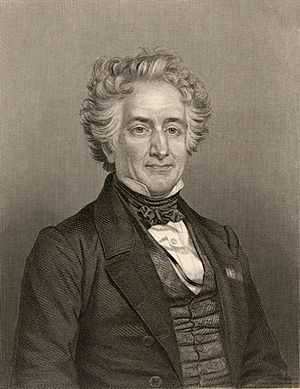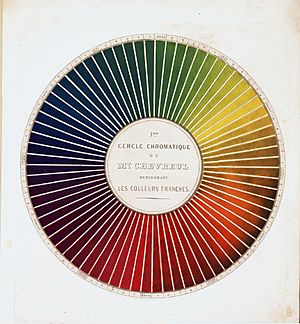Michel Eugène Chevreul facts for kids
Quick facts for kids
Michel Eugène Chevreul
|
|
|---|---|
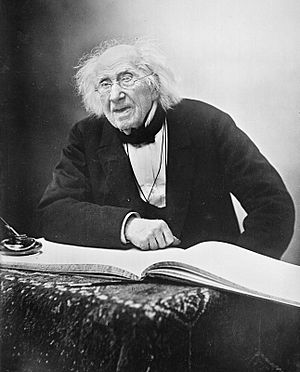
Michel Eugène Chevreul
|
|
| Born | 31 August 1786 Angers, France
|
| Died | 9 April 1889 (aged 102) Paris, France
|
| Known for | Creatine Fatty acids Margarine Chevreul's salt Color analysis |
| Awards | Copley Medal (1857) Albert Medal (1873) |
| Scientific career | |
| Fields | Chemistry |
Michel Eugène Chevreul (born August 31, 1786 – died April 9, 1889) was a French chemist. His amazing work helped science, medicine, and art grow a lot.
Chevreul's early studies on animal fats changed how soap and candles were made. He found and named important fatty acids like stearic and oleic acids. He was also the first scientist to clearly explain what a chemical compound is. He also described organic compounds, which are chemicals found in living things. Because of this, many people see him as a founder of modern organic chemistry.
In medicine, Chevreul was the first to show that people with diabetes have glucose (sugar) in their urine. He also found a substance called creatine. Chevreul also studied dyes for fabrics while working at the Gobelins Manufactory in Paris. His ideas about color greatly influenced Impressionism and Neo-Impressionism in painting.
Chevreul is one of the 72 French scientists, mathematicians, and engineers whose names are written on the Eiffel Tower. He lived to be 102 years old! He was also a pioneer in studying how people age, a field called gerontology.
A Look at Chevreul's Life
Michel Eugène Chevreul was born in Angers, France. His father was a doctor. His birth certificate shows that his father, grandfather, and a great-uncle were all surgeons.
When he was about 17, Chevreul moved to Paris. He started working in a chemistry lab with a famous chemist named L.N. Vauquelin. Later, he became Vauquelin's assistant at the National Museum of Natural History.
In 1813, Chevreul became a chemistry professor at a school called Lycée Charlemagne. After that, he became the director of the Gobelins tapestry factory. This is where he did his important research on how colors look next to each other. In 1839, he published his findings in a book. It was later translated into English as The Principles of Harmony and Contrast of Colors.
In 1826, Chevreul became a member of the French Academy of Sciences, a very important science group. That same year, he joined the Royal Society of London. He won their highest award, the Copley Medal, in 1857. He also became a member of the Royal Swedish Academy of Sciences in 1829 and the American Academy of Arts and Sciences in 1868.
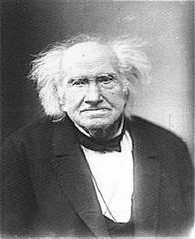
In 1830, Chevreul took over from his teacher, Vauquelin, as a professor of organic chemistry at the National Museum of Natural History. Thirty-three years later, he also became the museum's director. He stepped down as director in 1879 but kept his professorship.
When Chevreul turned 100 in 1886, it was a huge national celebration in France. A special bronze medal was made for him. He received letters from many leaders and kings, including Queen Victoria. He also had a series of meetings with the famous photographer Nadar. Nadar's son, Paul Nadar, took photos during these meetings. This created the first-ever photo-interview to appear in a magazine!
Chevreul started studying how aging affects the human body shortly before he passed away. He died in Paris on April 9, 1889, at the age of 102. He was given a public funeral to honor his life and work. In 1901, a statue was put up in his memory at the museum where he worked for so many years.
Chevreul's Amazing Discoveries
Chevreul's scientific work covered many different areas. But he is most famous for his studies on animal fats, which he wrote about in 1823. This research helped him understand exactly what soap is made of. He also discovered stearin, a white substance found in solid fats, and olein, the liquid part of fats. He also found and named stearic and oleic acids. His work led to big improvements in how candles were made.
Chevreul did not believe in fake science or tricks. He was very skeptical about things like "magic pendulums" or dowsing rods. In 1833 and 1854, he explained how these seemingly magical movements happen. He showed that they are caused by tiny, unconscious muscle reactions in people. He called this the ideomotor effect. Chevreul found that once a person realized their brain was causing the movement, it would stop. This was one of the first explanations of this effect.
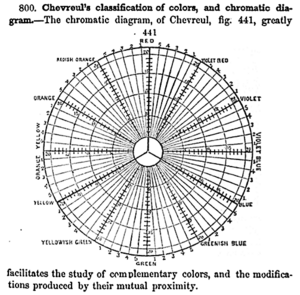
In 1824, Chevreul became the director of the dye works at the Gobelins Manufactory in Paris. People had complained that some dyes were not good enough. Chevreul found that some dyes were indeed poor. But he also noticed something interesting: a black dye that people criticized was actually very good. However, when this black fabric was placed next to deep blues or purples, it looked weak and reddish.
Chevreul called this effect simultaneous contrast. This means that a color seems to change its look when it's next to another color. It shifts towards the opposite (complementary) color of its neighbor.
He wrote a whole book about this idea in 1839. He wanted to create a complete theory for all visual arts. His book offered design ideas for tapestries, carpets, furniture, and even military uniforms! But it is most famous for how it influenced Impressionism and Neo-Impressionism in painting. This includes the Pointillist style used by artists like Georges Seurat and Paul Signac. They used tiny dots of complementary colors next to each other.
Chevreul also said it was important to show lighting accurately to make things look real. But he added that "exaggerated coloring is found more pleasing than absolute fidelity." Vincent van Gogh took this advice to heart. He used complementary colors a lot to make them look more intense. Van Gogh wrote that when complementary colors are placed together, they can become so strong that "human eyes will scarcely be able to bear to look at it."
Chevreul's ideas also influenced 20th-century painting, especially the work of Robert Delaunay. Delaunay's style of mixing large blocks of nearly complementary colors is called Orphism today. But Delaunay himself preferred the name "Simultanism," which was a clear nod to Chevreul.
Chevreul is also connected to what is sometimes called Chevreul's illusion. This is when bright edges seem to appear between strips of the same color that have different brightness levels. You can find more information in Chevreul's book, The Laws of Contrast of Colour.
See also
 In Spanish: Michel Eugène Chevreul para niños
In Spanish: Michel Eugène Chevreul para niños


